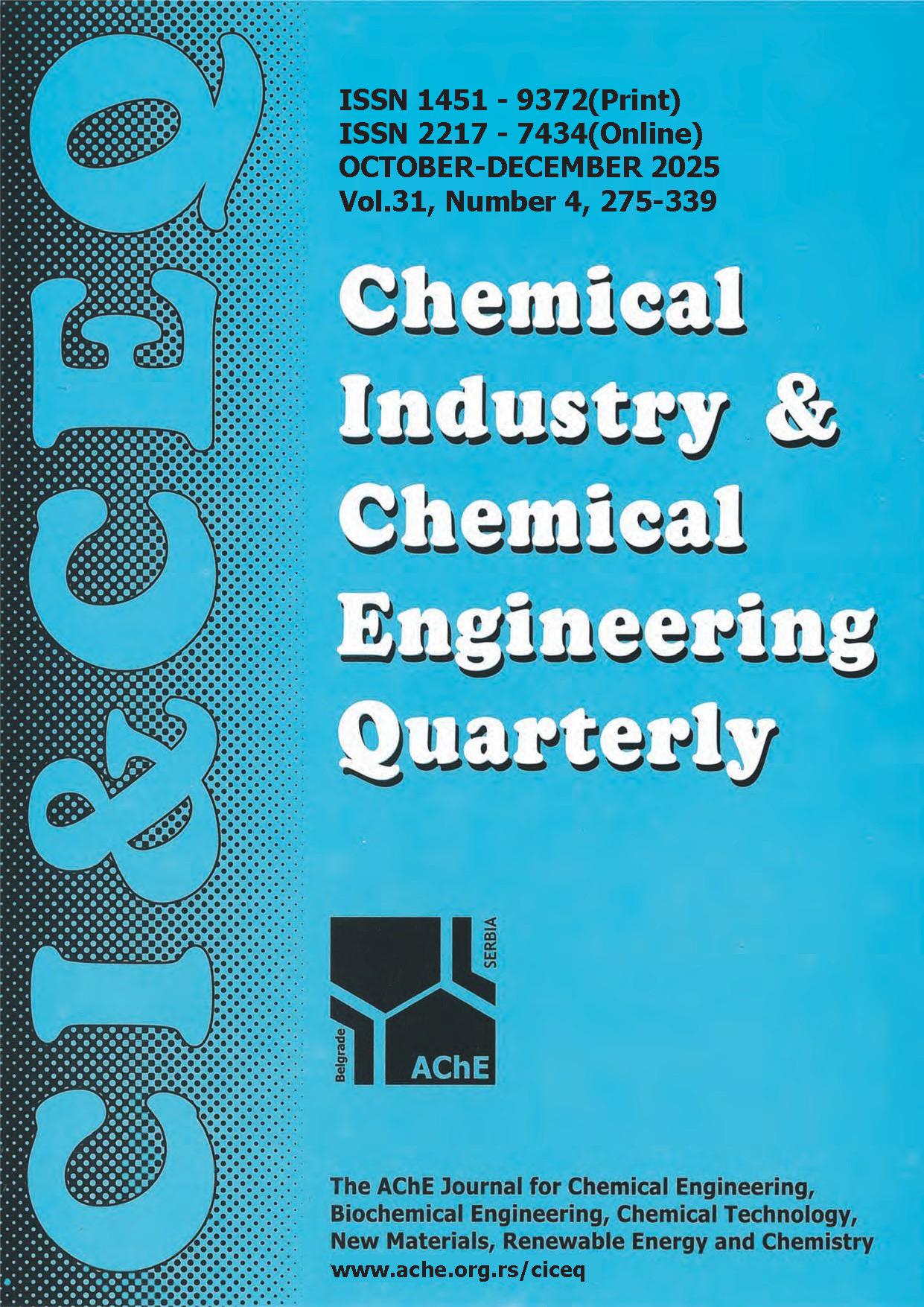COMPARATIVE ANALYSIS OF WATER NETWORK MINIMIZATION IN INDUSTRIAL PROCESSES: REGENERATION VS. NON-REGENERATION METHODS
Original scientific paper
DOI:
https://doi.org/10.2298/CICEQ240213036KKeywords:
Contaminant removal, mathematical modeling, optimization algorithms, regeneration methods, water network minimizationAbstract
The utilization of a regeneration method in water networks provides a distinct benefit by effectively decreasing the usage of freshwater and the release of wastewater; while also preventing the accumulation of contaminants; it is crucial to employ appropriate process decomposition strategies. In this study, the primary objective is to analyze the disparity between water networks that incorporate a regeneration unit and those that do not; in addition to addressing the primary objective of minimizing fresh water usage, this study focuses on examining the influence of different process decomposition strategies on the reduction of freshwater consumption using the concentration-mass load diagram as a tool for analysis. Moreover, an approach for determining interim concentrations in multiple-contaminant water systems during the concentration decomposition process was explored. Through the reduction of freshwater consumption, regenerated water flow rate, and contaminant regeneration load, the overall impact on freshwater resources was minimized, and an optimally designed regeneration recycling water network was synthesized. The evidence of the feasibility and efficacy of the proposed approach was provided by showcasing three case studies. The outcomes of the selected literature examples indicated that the designs achieved through this approach were comparable to those found in the existing literature.
References
[1] H. H. Chin, P. Y. Liew, P. S. Varbanov, J. J. Klemeš, Chem. Eng. Sci. 248 (2022), 117223. https://doi.org/10.1016/j.ces.2021.117223.
[2] F.S. Francisco, M. Bavar, F.L.P. Pessoa, E M. Queiroz, H. Asgharnejad, M.H. Sarrafzadeh, J. Water Process Eng. 47 (2022) 102758. https://doi.org/10.1016/j.jwpe.2022.102758.
[3] H.P. Zhao, X.Y. Fan, Z.Y. Liu, Chem. Eng. Sci. 91(2013), 162—172, 2013. https://doi.org/10.1016/j.ces.2013.01.025.
[4] B.J. Singh, A. Chakraborty, R. Sehgal, J. Environ. Manage 348 (2023) 119230. https://doi.org/10.1016/j.jenvman.2023.119230.
[5] É. Hansen, M.A.S. Rodrigues, M.E. Aragão, P.M. de Aquim, J. Clean. Prod. 172 (2018) 1814—1822. https://doi.org/10.1016/j.jclepro.2017.12.005.
[6] D.C. de Faria, A.A. Ulson de Souza, S.M. de A. Guelli Ulson de Souza, J. Clean. Prod. 17 (9) (2009) 857—862. https://doi.org/10.1016/j.jclepro.2008.12.012.
[7] T. Budak Duhbacı, S. Özel, S. Bulkan, J. Clean. Prod. 284 (2021) 124752. https://doi.org/10.1016/j.jclepro.2020.124752.
[8] W. Zhao, T. H. Beach, Y. Rezgui, IEEE Trans. Syst. Man. Cybern. Syst. 46(5) (2015) 659—681. https://ieeexplore.ieee.org/document/7185445.
[9] M. Souifi, A. Souissi, Mater. Today Proc.13 (2019) 1115—1124. https://doi.org/10.1016/j.matpr.2019.04.079.
[10] F. Boukouvala, R. Misener, C. A. Floudas. Eur. J. Oper. Res. 252(3) (2016) 701—727. https://doi.org/10.1016/j.ejor.2015.12.018.
[11] K. Nemati Amirkolaii, H. Romdhana, M.L. Lameloise, Sustainability 11(16)(2019) 4492. https://doi.org/10.3390/su11164492.
[12] G.K.C. Ding, Encycl. Sustain. Technol. (2017) 43—52. https://doi.org/10.1016/B978-0-12-409548-9.10170-8.
[13] C. Pan, J. Shi, Z. Liu, AIChE J. 58(2) (2012) 456—465. https://doi.org/10.1002/aic.12595.
[14] M. Gutterres, P.M. de Aquim, in Wastewater Reuse and Management, S. Sharma, R. Sanghi (Eds.). Springer, Dordrecht (2012), p. 127—164. https://doi.org/10.1007/978-94-007-4942-9_5.
[15] E. Mehregan, A. Mahmoudi, Medbiotech J.4(1) (2020) 8—12. http://www.medbiotech.net/article_105333.html.
[16] N. Ibrić, E. Ahmetović, Z. Kravanja, I.E. Grossmann, Energy 235 (2021) 121354. https://doi.org/10.1016/j.energy.2021.121354.
[17] W.C. Kuo, R. Smith, Process Saf. Environ. Prot.76(2) (1998) 94—114. https://doi.org/10.1205/095758298529399.
[18] Z.Y. Liu, Y.M. Li, Z.H. Liu, Y.J. Wang, AIChE J. 55(6) (2009) 1628—1633. https://doi.org/10.1002/aic.11748.
[19] D.C. Faria, M.J. Bagajewicz, AIChE J. 56(3) (2010) 668—689. https://doi.org/10.1002/aic.11983.
[20] Z. Liu, Y. Yang, L. Wan, X. Wang, K. Hou, AIChE J. 55(2) (2009) 374—382. https://doi.org/10.1002/aic.11693.
Downloads
Published
Issue
Section
License
Copyright (c) 2023 Azza Mohamed Khalifa, Nadia Ali Elsayed, Mostafa Awad

This work is licensed under a Creative Commons Attribution-NonCommercial-NoDerivatives 4.0 International License.
Authors who publish with this journal agree to the following terms:
Authors retain copyright and grant the journal right of first publication with the work simultaneously licensed under a Creative Commons Attribution License that allows others to share the work with an acknowledgement of the work's authorship and initial publication in this journal.
Authors grant to the Publisher the following rights to the manuscript, including any supplemental material, and any parts, extracts or elements thereof:
- the right to reproduce and distribute the Manuscript in printed form, including print-on-demand;
- the right to produce prepublications, reprints, and special editions of the Manuscript;
- the right to translate the Manuscript into other languages;
- the right to reproduce the Manuscript using photomechanical or similar means including, but not limited to photocopy, and the right to distribute these reproductions;
- the right to reproduce and distribute the Manuscript electronically or optically on any and all data carriers or storage media – especially in machine readable/digitalized form on data carriers such as hard drive, CD-Rom, DVD, Blu-ray Disc (BD), Mini-Disk, data tape – and the right to reproduce and distribute the Article via these data carriers;
- the right to store the Manuscript in databases, including online databases, and the right of transmission of the Manuscript in all technical systems and modes;
- the right to make the Manuscript available to the public or to closed user groups on individual demand, for use on monitors or other readers (including e-books), and in printable form for the user, either via the internet, other online services, or via internal or external networks.




